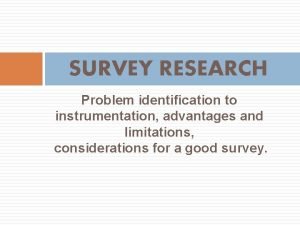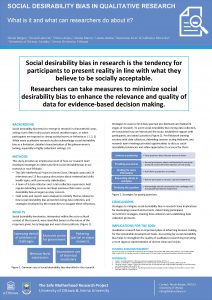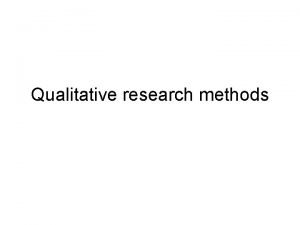SAMPLING IN QUALITATIVE RESEARCH Definition Sampling is the
































- Slides: 32

SAMPLING IN QUALITATIVE RESEARCH

Definition Sampling is the process of selecting a number of individuals from a population, in such a way that the individuals represent the larger group from which they were selected (Fraenkel & Wallen, 1993).

Researcher has to make judgments about four key factors in sampling • • The sample size. Representativeness and parameters of the sample. Access to the sample. The sampling strategy to be used.

The Sample Size • There is no clear-cut answer, for the correct sample size, depends on the purpose of the study and the nature of the population. • Generally, the larger the sample the better, as this not only gives greater reliability but also enables more sophisticated statistics to be used. • Financial and time restrictions also limit the size of the sample.

Contd. . • Sample size depends on the style of research (e. g. surveys may require large samples, ethnographies may require smaller samples). • Samples in qualitative research must be large enough to generate ‘thick descriptions’. • A large sample does not guarantee representativeness; representativeness depends on the sampling strategy. • Sample size also depends on the heterogeneity or homogeneity of the population: If it is highly homogeneous then a smaller sample may be possible.

Proportion of Sample Size to Population As the population increases, the proportion of the population in the sample decreases (Cohen, Manlon & Morrison, 2007). N 10 15 30 100 200 300 S 10 14 28 80 132 169 N 400 500 1, 000 1, 500 3, 000 5, 000 N = Population S = Sample S 196 217 278 306 346 357

The Representativeness of the Sample To get the representativeness of the sample following points should be considered: • The selection of the sample should be done in such a way that the selected sample should concentrate only on those variables that are relevant to research. • The sample can’t be identical but it should be approximately the same as population.

Access to the Sample According to Bailey, (1950): • Most public areas – no permission is required. • Places where formal consent is required. • Closed private settings (homes). • Schools and institutions have rules and regulations for security reasons. • Certain status characteristics (gender / religion / age / race / ethnicity) make access difficult or impossible. Procedures to take permissions or follow the channel will make it more time consuming, so the researcher should keep it in mind.

Sampling Strategies There are two main methods of sampling: • Probability sample • Non-probability sample

Probability Sample • Every member of the wider population has an equal chance to be included. • Choice is made on chance alone. • The aim is for generalizability and wide representation. • Less risk of bias in the sample.

Non-probability Sample • The selectivity which is built into a nonprobability sample derives from the researcher targeting a particular group, in the full knowledge that it does not represent the wider population; it simply represents itself. • This is frequently the case in small-scale research, for example, as with one or two schools or where no attempt to generalize is desired. • This is frequently the case for some ethnographic research, action research or case study research.

• Members of the wider population are deliberately excluded. • The aim is for the sample to represent itself rather than to seek generalizability. • Non-probability sampling techniques are far less complicated to set up. • This main significance of non-probability is that it is convenient and economical. According to Bailey (1982), non-probability is much less complicated.

It Includes: • • Convenience sampling Quota sampling Purposive sampling Dimensional sampling Snowball sampling Volunteer sampling Theoretical sampling

Planning a Sampling Strategy Cohen, Manlon & Morrison (2007) divide sampling strategy in eight stages: • Stage One: Decide whether the study needs a sample, or whether it is possible to have the whole population. • Stage Two: Identify the population, its important features (the sampling frame) and its size. • Stage Three: Identify the kind of sampling strategy that is required (e. g. probability, non-probability, or mixed methods sample). • Stage Four: Ensure that access to the sample is guaranteed. If not, be prepared to modify the sampling strategy.

Contd. . Stage Five: For non-probability sampling, identify the people whom you require in the sample. Stage Six: Calculate the numbers required in the sample, allowing for non-response, incomplete or spoiled responses and sample mortality. Stage Seven: Decide how to gain and manage access and contact. Stage Eight: Be prepared to adjust the data, once collected.

Qualitative versus Quantitative Sampling Qualitative Sampling Selected elements are representative Select elements according to research of target population focus Generalize from sample to population Generate detailed and subjective understanding Make claims about the population Answer research questions Test theories within population Build theories

Techniques of Qualitative Sampling Convenience sampling as it is sometimes called, accidental or opportunity sampling involves choosing the nearest individuals to serve as respondents. Researchers simply choose the sample from those to whom they have easy access. As it does not represent any group apart from itself, it does not seek to generalize about the wider population. A convenience sample may be the sampling strategy for a case study or a series of case studies.

Quota Sample Quota sampling has been described as the non-probability equivalent of stratified sampling (Bailey 1978). Like a stratified sample, a quota sample strives to represent significant characteristics (strata) of the wider population; unlike stratified sampling it sets out to represent these in the proportions in which they can be found in the wider population.

Example of a Proportionate/Quota Sample from a University Total number of students in school is 1700 Performing arts: 300 students Natural sciences: 300 students Humanities: 600 students Business & social sciences: 500 students Proportions: 3: 3: 6: 5 Minimum required is 3 + 6 + 5 = 17 The proportions being 3: 3: 6: 5, a minimum of 17 students might be required (3 + 6 + 5) for the sample.

Purposive Sample In purposive sampling researchers handpick the cases to be included in the sample on the basis of their judgment of the particular characteristics being sought. In this way, they build up a sample that is satisfactory to their specific need, for example: a group of principals and senior managers of secondary schools is chosen as the research is studying the incidence of stress among senior managers

Kinds of Purposive Sampling Subjects are selected because of some characteristic. Patton (1990) has proposed the following cases of purposive sampling. Maximum variation sampling, also known as heterogeneous sampling, is a purposive sampling technique used to capture a wide range of perspectives relating to the thing that you are interested in studying. By conditions, we mean the units (i. e. , people, cases/organizations, events, pieces of data) that are of interest to the researcher. These units may exhibit a wide range of attributes, behaviors, experiences, incidents, qualities, situations, and so forth.

Homogeneous Sampling Homogeneous sampling is a purposive sampling technique that aims to achieve a homogeneous sample; that is, a sample whose units (e. g. , people, cases, etc. ) share the same (or very similar) characteristics or traits (e. g. , a group of people that are similar in terms of age, gender, background, occupation, etc. ).

Typical Case Sampling Typical case sampling is a purposive sampling technique used when you are interested in the normality/typicality of the units (e. g. , people, cases, events, settings/contexts, places/sites) you are interested, because they are normal/typical. The word typical means that the researcher has the ability to compare the findings from a study using typical case sampling with other similar samples (i. e. , comparing samples, not generalizing a sample to a population).

Extreme (or Deviant) Case Sampling Extreme (or deviant) case sampling is a type of purposive sampling that is used to focus on cases that are special or unusual, typically in the sense that the cases highlight notable outcomes, failures or successes. These extreme (or deviant) cases are useful because they often provide significant insight into a particular phenomenon, which can act as lessons (or cases of best practice) that guide future research and practice.

Total Population Sampling Total population sampling is a type of purposive sampling technique where one chooses to examine the entire population (i. e. , the total population) that have a particular set of characteristics (e. g. , specific experience, knowledge, skills, exposure to an event, etc. ).

Expert Sampling Expert sampling is a type of purposive sampling technique that is used when the researcher needs to gain knowledge from individuals that have particular expertise. Expert sampling is particularly useful where there is a lack of empirical evidence in an area and high levels of uncertainty, as well as situations where it may take a long period of time before the findings from research can be uncovered.

Snowball Sampling In snowball sampling researchers identify a small number of individuals who have the characteristics in which they are interested. These people are then used as informants to identify, or put the researchers in touch with, others who qualify for inclusion and these, in turn, identify yet others – hence the term snowball sampling. This method is useful for sampling a population where access is difficult, maybe because it is a sensitive topic or where communication networks are undeveloped.

Person 1 RESEARCHER Friend/contact 1 contacts his/her own friends/contacts/ 4 5 RESEARCHER HAS 3 CONTACTS Friend/contact 2 contacts his/her own friends/contacts/ 6 7 8 9 Friend/contact 3 contacts his/her own friends/contacts/ 10 11 12 THE 3 CONTACTS EACH HAVE 3 CONTACTS

Volunteer Sampling In cases where access is difficult, the researcher may have to rely on volunteers, for example, personal friends, or friends of friends, or participants who reply to a newspaper advertisement, or those who happen to be interested from a particular school, or those attending courses. Sometimes this is inevitable, as it is the only kind of sampling that is possible, and it may be better to have this kind of sampling than no research at all. Caution: people volunteer for different motives, e. g. : • Wanting to help a friend • Interest in the research • Wanting to benefit society • Revenge on a particular school or head teacher.

Theoretical Sampling The researcher must have sufficient data to be able to generate and ‘ground’ theory in the research context, i. e. to create theoretical explanation of what is happening in the situation, without having any data that do not fit theory. The researcher proceeds in gathering more and more data until theory remains unchanged, until no modifications to the grounded theory are made in light of the constant comparison method. Theoretical saturation occurs when no additional data are found that advance, modify, qualify, extend or add to theory developed.

Types of Sampling in Qualitative Researches Qualitative research Type of sampling Descriptive Convenient or purposive Ethnography Purposive, knowledgeable informants Phenomenology Purposive sample of volunteers Grounded Theory Theoretical sampling; purposive initially and expanded, based on findings until data saturation is achieved

THANK YOU
 Qualitative quota sampling
Qualitative quota sampling Phenomenology research topics
Phenomenology research topics What is the sample size in qualitative research?
What is the sample size in qualitative research? Sampling techniques in qualitative research
Sampling techniques in qualitative research Sample of ethical consideration in research
Sample of ethical consideration in research Chapter 3 research methodology sample quantitative
Chapter 3 research methodology sample quantitative Research design
Research design Purpose of qualitative research
Purpose of qualitative research What is non probability sampling
What is non probability sampling Sampling method in research
Sampling method in research Cluster sampling advantages and disadvantages
Cluster sampling advantages and disadvantages Probability sampling
Probability sampling Perbedaan time sampling dan event sampling
Perbedaan time sampling dan event sampling Cluster sampling vs stratified sampling
Cluster sampling vs stratified sampling Natural sampling vs flat top sampling
Natural sampling vs flat top sampling Findings of qualitative research
Findings of qualitative research Holistic research approach
Holistic research approach Kind of quantitative research
Kind of quantitative research What is methodological integrity
What is methodological integrity What is a survey research method
What is a survey research method Social desirability bias in qualitative research
Social desirability bias in qualitative research Qualitative research traditions
Qualitative research traditions Result and discussion
Result and discussion Research questions examples
Research questions examples Expected result in research proposal example
Expected result in research proposal example Descriptive correlational design definition
Descriptive correlational design definition Observation sheet in qualitative research
Observation sheet in qualitative research What is the sample size in qualitative research?
What is the sample size in qualitative research? Research gap example
Research gap example Analytic induction qualitative research
Analytic induction qualitative research Qualitative research design
Qualitative research design Disadvantage of qualitative research
Disadvantage of qualitative research Strenghts of quantitative research
Strenghts of quantitative research
























































